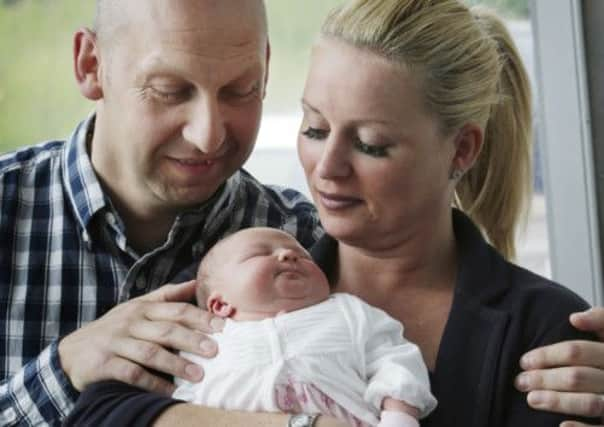Glasgow baby named after new form of IVF treatment


Little Eva was born in Glasgow on Tuesday thanks to the cutting-edge early embryo viability assessment (Eeva).
And yesterday the three-day-old was taken to see staff at the Glasgow Centre for Reproductive Medicine (GCRM) by her parents, Susan Walker-Dempster and David Dempster.
Advertisement
Hide AdAdvertisement
Hide AdThe clinic’s medical director, Dr Marco Gaudoin, described the system as “probably the most important development in IVF in the past five years”.
Eeva uses time-lapse imaging to monitor embryos while they are being incubated, and then employs computer software to select the best embryos at low risk of defects.
Pictures taken at five-minute intervals by the computer tell embryologists which embryos are best and most likely to deliver a full pregnancy.
In standard IVF, embryos are removed from the incubator once a day to be checked under the microscope.
The Eeva system is similar to time-lapse imaging used by other fertility clinics, but it produces images every five minutes as opposed to every ten to 20 minutes and the results are analysed by computer rather than a clinician.
The Dempsters, who are celebrating the birth of their first child together, were the first to conceive under the technique last September, even though they did not know the full details of the process. Mrs Walker- Dempster said: “We came to GCRM and were asked by the embryologist if we wanted to use this Eeva system just before I went into theatre.
“So we didn’t actually read all the information as you should, but it’s not intrusive and we thought it wouldn’t do any harm so we signed up for it, thinking we were one of the first, and here we are today with Eva.”
The couple told their parents that they were using the new treatment, which was developed at Stanford University in the US.
Advertisement
Hide AdAdvertisement
Hide AdMrs Walker-Dempster, 35, said: “Our parents knew about the treatment, but not many of our other friends and family did.
“They know we used GCRM but they didn’t know we were among the first to use Eeva and the significance of the birth in terms of the new programme.”
The Dempsters had always planned to call their baby Eva if it was a girl and said she was not named after the new IVF treatment.
“It’s a total coincidence,” Mrs Walker-Dempster said. “Before I was pregnant, and probably before we even came to GCRM, we spoke about child names and it was Eva for a girl and Max for a boy.”
The GCRM clinic is the first in Scotland, and only the second in Europe, to adopt the test and make it available to patients.
It is hoped the use of the test will increase the chances of success for women undergoing IVF.
Dr Gaudoin said: “Previously we haven’t had the technology to tell us when cell divisions happen. Eeva now gives us that ability.
“The embryos never leave the incubator, which in itself is probably a good thing.”